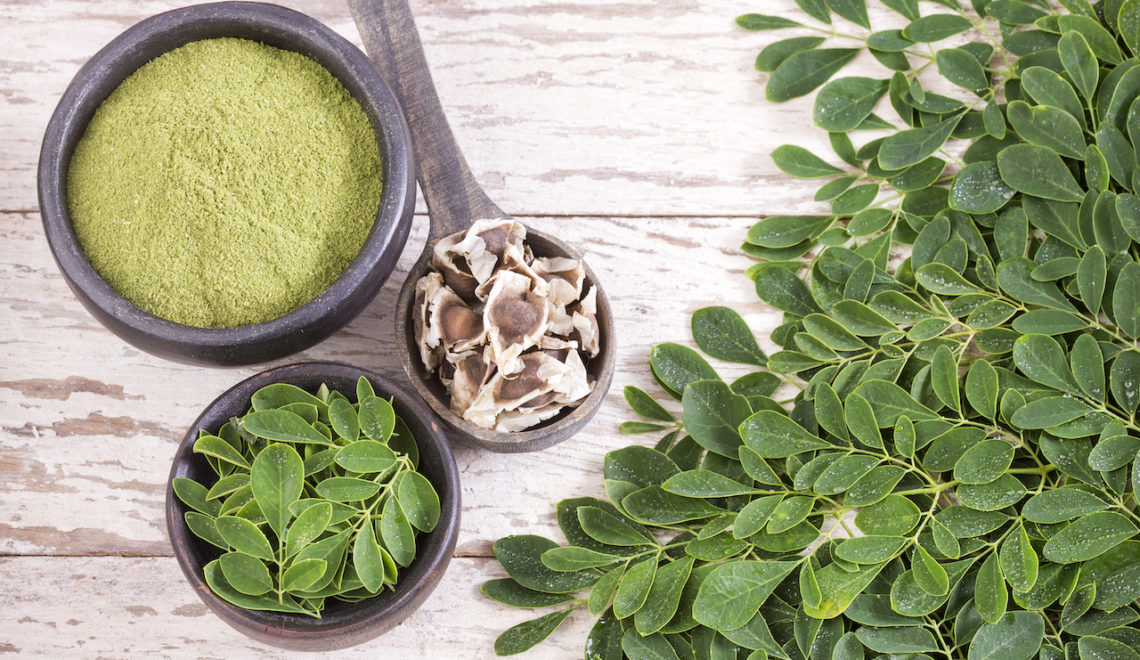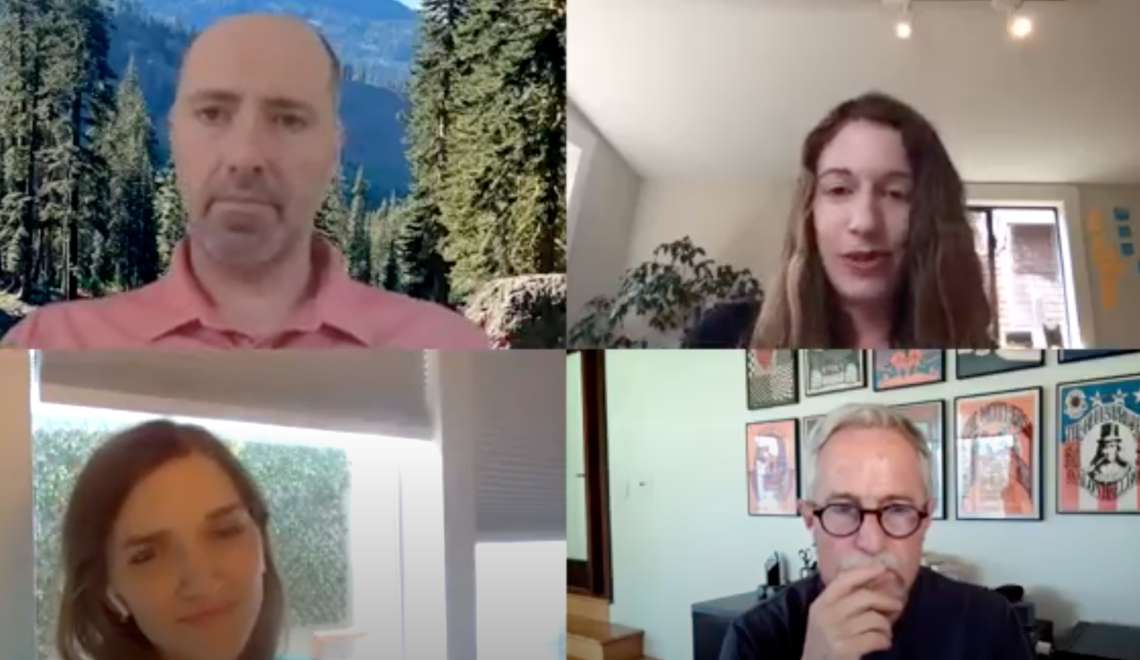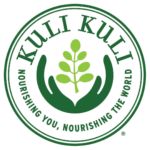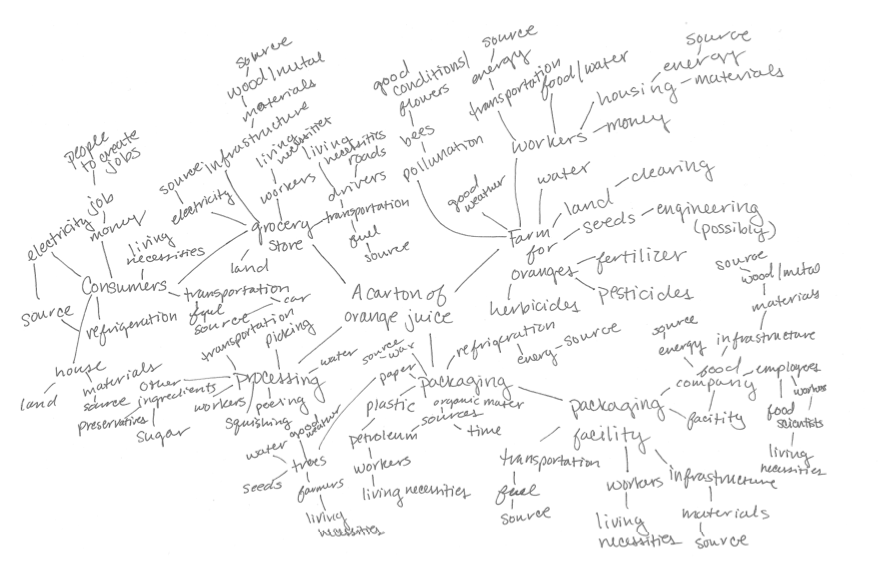
Where does our food come from? A store? A farm? The mind of a food scientist or marketing representative? What happens to the waste from our food after we throw it into the garbage? What waste products are produced during the manufacturing of a food product? How much energy does it take to produce food anyway?
If you think about it, each food product we buy, use, and consume almost has a life. It’s created, taken care of, and things are done to it to make it into the product you know and love. Then, when it’s finally ready, it’s allowed to be taken to the grocery store; someone buys it and eventually consumes it. In your body, the food fuels processes that keep you alive. At all points, waste is produced, which has a process of its own. Waste of any type may be made into something else, or it will live out its potentially extremely long life in a landfill somewhere. Moreover, each food product takes energy to be made, processed, transported, maintained, consumed, and broken down within a body. This energy comes from many different sources whether renewable or nonrenewable.
In order to make safe, high-quality food products a large amount of energy must be expended. Many forms of energy used in the production of food create a great deal of carbon dioxide and other gas emissions that are released into our atmosphere, contributing to global climate change.
The tool for evaluating the environmental effects of a food product during its lifetime is called a Life Cycle Assessment (LCA). The concept of LCAs has been around since the 1960s, and has been developing since then. Many different countries have their own concept and procedures for evaluating the life cycle of products, processes, or activities. Though they differ in some aspects, they all have similar processes and targets: setting the ultimate goal and scope of the assessment, collecting data about the life cycle of the subject being studied, understanding environmental impacts of the subject, and drawing conclusions of the assessment.
For the average consumer, it would be quite a daunting task to try and perform a LCA on our favorite foods. However, it is important that all consumers realize the impact of food production on the world and exactly what goes into creating a food product. As citizens of this planet, it is out duty to know and understand how our food is produced and even wonder if it’s the best way to go about it. “Environmental awareness influences the way in which legislative bodies such as governments will guide the future development of agricultural and industrial food production systems” (Roy, et al 2009).
Now it’s your turn. Although performing a LCA on your favorite food product is not exactly possible, there is a simple exercise anyone can do to appreciate more fully all the processes and energy that goes into food production. Here’s how:
- Think of a food product. It could be a simple product or complex: one with many ingredients, or just one. Don’t forget to specify the packaging and be specific. I’m going to use a carton of orange juice as an example.
- Using a piece of paper put the name of your product in the middle. Draw a web diagram using lines to connect your product to an ingredient or process that your product needs in order to be made.
- Use parts of the supply chain that you’d need to know about.
- Use components like raw materials, manufacturing, assembly, consumer use, and disposal of the product.
- Indicate where energy is used in the system and what type of energy it may be.
- If you can, think about what waste or co-products may be created at certain steps and whether or not those products may be used for a completely different process or just discarded.
What do you notice about the diagram you made? Is there anything surprising you’ve found? Do you think the process would be different if the product were made organically? Produced local? Would it depend on the specific processes or types of energy used? How would your diagram compare if you produced the product yourself?
Here’s my diagram on a carton of orange juice:
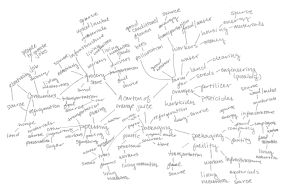
A lot goes into the production of food; that much is clear. The thing is, the mass production of food is not wrong or even bad. It’s a great way to get food to millions of people. Large food production processes can also help improve the safety and quality of products through government regulations and inspections. However, the way that we produce food is not perfect and can always be improved. With the concern of global climate change, it is our duty to look at the processes we use to find ways to improve them. It is the responsibility of everyone to assess our current situation and even help to make changes in whatever ways they can. It is our planet and we all want to continue to fuel and feed it.
Sources
Roy, Poritosh, Daisuke Nei, Takahiro Orikasa, Qingyi Xu, Hiroshi Okadome, Nobutaka Nakamura, and Takeo Shiina. “A Review of Life Cycle Assessment (LCA) on Some Food Products.” Journal of Food Engineering 90.1 (2009): 1-10. Web. 16 Sept. 2014. <http://www.sciencedirect.com/science/article/pii/S0260877408002793>.
Hill, Jason. “How Can We Make Good Decisions in a Complex World? Part II: Quantitative Approaches.” How Do We Feed the World Without Destroying It? Learning and Environmental Sciences, St. Paul. 15 Sept. 2014.


